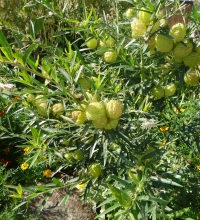Asclepias physocarpa is a species of milkweed. The plant is native to southeast Africa, but it has been widely naturalized. It is often used as an ornamental plant.
The name "balloon plant" is an allusion to the swelling bladder-like pods which are full of seeds.
This undershrub perennial herb can grow to over 2 m in height. The plant blooms in warm months. The plant prefers moderate moisture, as well as sandy and well-drained soil and full sun.
The flowers are small, with white hoods and about 1 cm across.
The capsule is a pale green, and the shape of an inflated sphere. It is covered with rough hairs. It reaches 8 cm in diameter.
The leaves are light green, linear to lanceolate and up to 10 cm long, 1.2 cm broad. The seeds have silky tufts (pappus).
The plant is a food source for the caterpillars of Danaus butterflies, and is a specific Monarch butterfly food and habitat plant. It is also popular in traditional medicine to cure various ailments. All of the milkweeds are named for a milky sap in the plant's stem and leaves.
After the Monarch caterpillar has metamorphosed into a butterfly, the alkaloids from the sap they ingested from the plant are retained in the butterfly, making it unpalatable to predators.
Swan plants (Asclepias spp.) are toxic, and swallowing even a small amount could be a problem. Ingestion of the plant material can affect the heart, breathing, central nervous system and the stomach
To attract monarch butterflies & teach children the life cycle of the monarch
By seed

